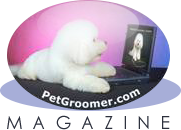by Jeff Andrews of Northern Tails Sharpening
When you buy new shears or receive your shears back from the sharpener, they are adjusted to cut. When I adjust shears it is for the cutting needs of pet groomers, especially tips and front ends of shears.
The adjustment for tension (or balance as some call it) is a screw or thumb wheel on the pivot of the shears. Beveled edge shears are adjusted in order for the blades to grab about three-quarters of an inch from their tips. This enables the blades to slice from the pivot all the way to the tips. If tension is not set like this on beveled 10” shears, the blades may push apart from one another in thicker coat and fold at the tips.
There is a space between the blades of beveled shears that has to be there. It gives the shear the “slicing” action it needs to get through tough coats with ease. This type of edge is the workhorse of the grooming industry and can be used on any type of coat. The edge lasts for months unless you drop them or hit something in the coat and create a nick.
Convex shears have a different edge all together and must be sharpened differently. Their edges are razors.
Convex edges are honed on both sides, first on the diamond wheel to create the edge, and then the interior of the blades. The result is edges like razors.
Convex shears have little or no space between the blades because they are so sharp they “chop” through hair rather than slicing to produce a beautiful cut used in finish work. Tension is adjusted to where blades start to grab one-third to one-half the way down from the tips keeping the blades as close as possible to each other. If the tension is too loose on a convex shear two things can happen: the blades may grab ¾ of an inch from the pivot creating a gouge, and they can fold hair at the tips.
Note: The tension adjustment simply adjusts the way the shear cuts. It is not for the convenience or ease of the way the shear opens and closes. Tension may be adjusted a little, but if it is adjusted to where the shear feels loose because of hand or scissoring problems, that is not good. Instead there are shears available with ball bearings in the pivot. This type of shear feels loose no matter what the tension adjustment.
Clean your shears daily. Wipe all the hair from the inside of the blades. Hair attracts moisture which can rust your shears. If the blades have grime or hairspray on them use a Handi-Wipe to remove. Never leave shears dirty. It will cause problems down the road.
Lubricate shears with shear lube only. It contains silicon and a light solvent. Not lubricating can cause the screw to rust and not stay tight.
When there is moisture in your pivot from scissoring lube will get rid of it. Not lubing can cause tiny pieces of hair and pet dander to remain in the pivot. This will tighten the tension, slow the shear down and cause a binding feel when scissoring.
Lube the shear. Then open and close the shears a few times to spread the lube around the pivot well.
Convex shears should be lubed more often than beveled shears. Never use blade oil on shears or they will stiffen over time. ♦




